Business Finance MOD003319 Report: Budgeting Methods Comparison
VerifiedAdded on 2023/01/19
|12
|3225
|87
Report
AI Summary
This report examines budgeting methods for Snappy Drinks Inc., focusing on the transition from traditional to alternative approaches. It begins by outlining the benefits of budgeting and the budgeting process itself. The report then explores the limitations of traditional budgeting, particularly in the context of Snappy Drinks' expansion plans, and analyzes the advantages and disadvantages of rolling, zero-based, and activity-based budgets. The report assesses the suitability of each method for the company, considering their respective strengths and weaknesses, and concludes by recommending the most appropriate budgeting strategies for Snappy Drinks to effectively manage costs and plan for future growth. The report is divided into two parts, with the first part discussing the budget process and the application of traditional budgeting approaches. The second part deals with alternative budgeting methods.
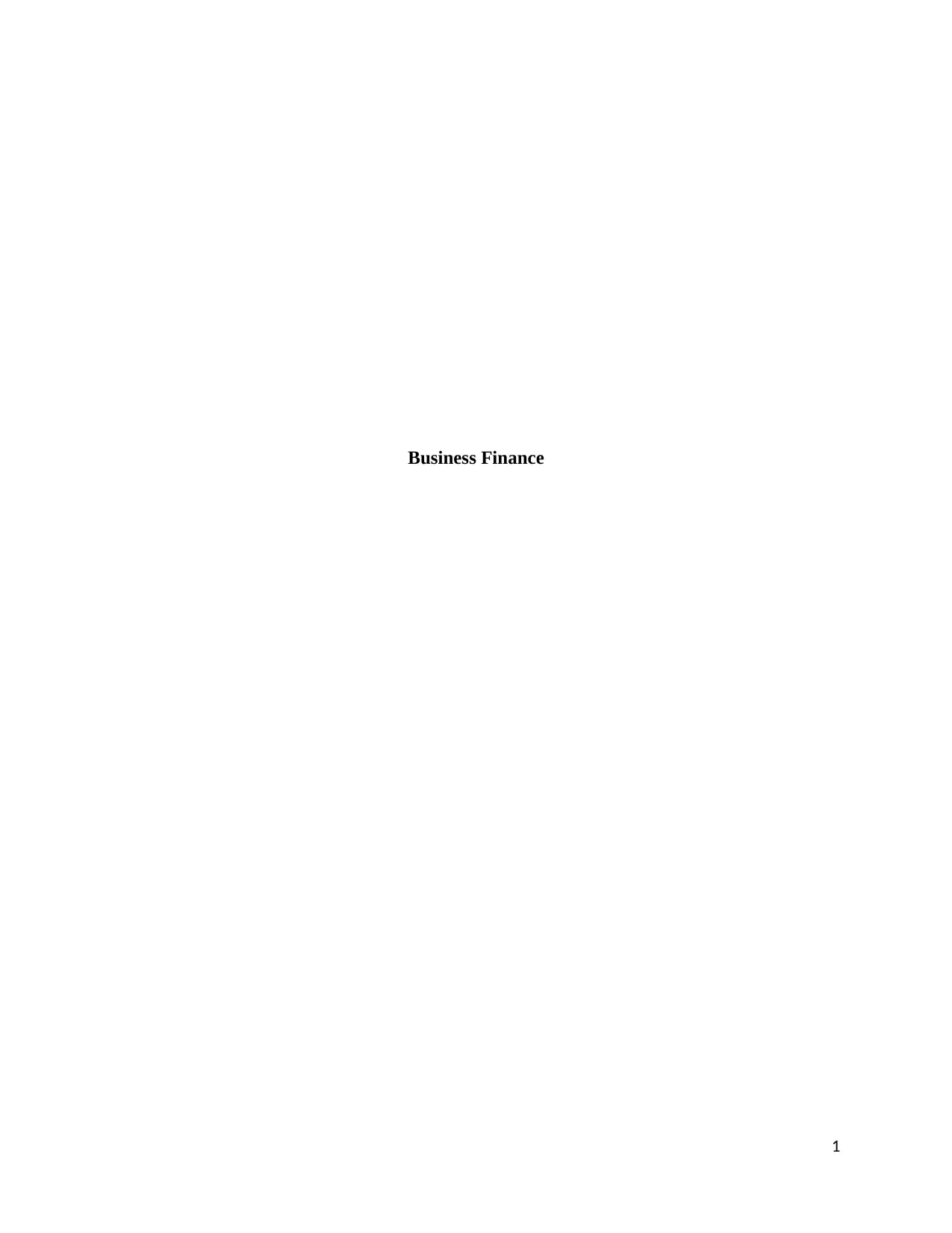
Business Finance
1
1
Paraphrase This Document
Need a fresh take? Get an instant paraphrase of this document with our AI Paraphraser
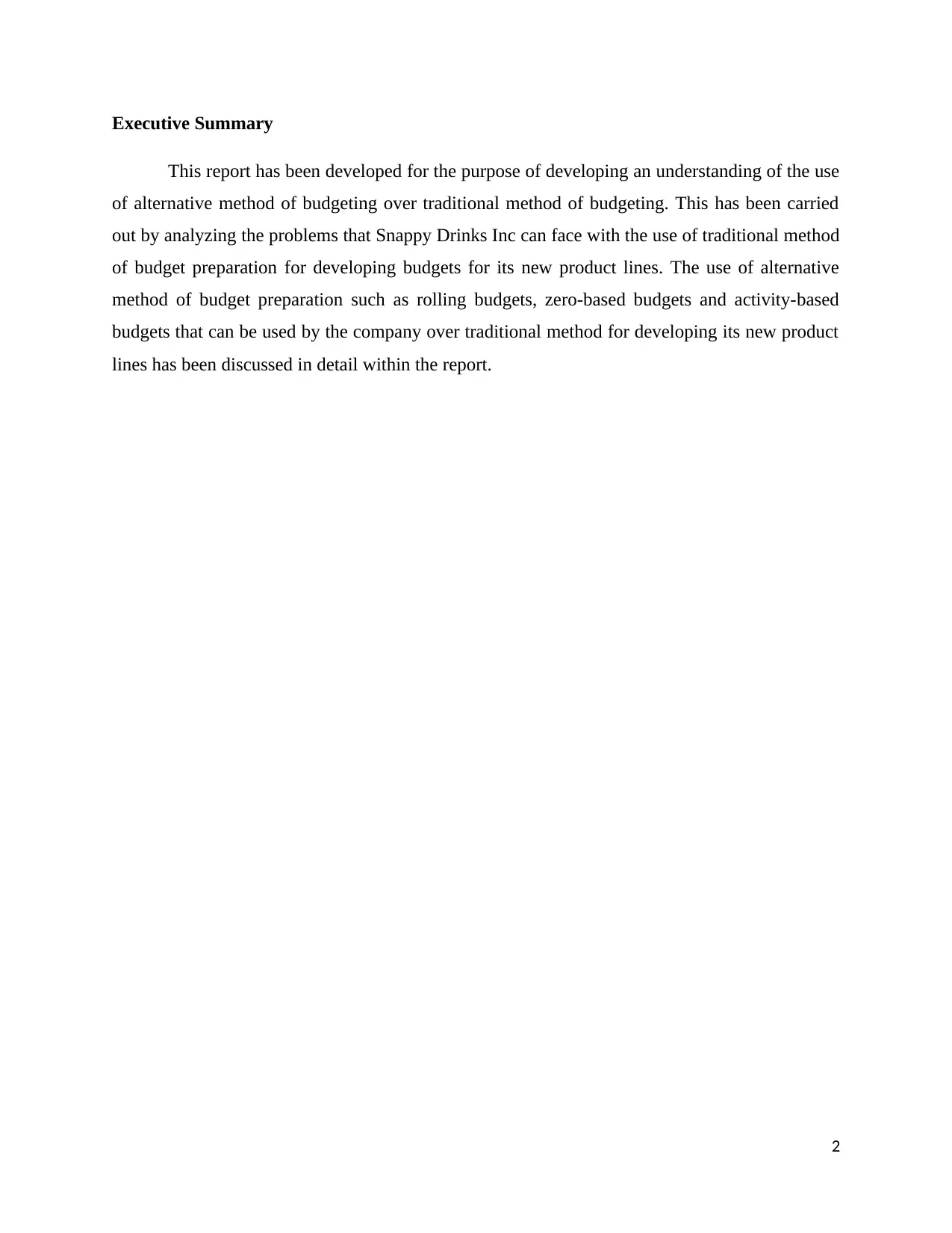
Executive Summary
This report has been developed for the purpose of developing an understanding of the use
of alternative method of budgeting over traditional method of budgeting. This has been carried
out by analyzing the problems that Snappy Drinks Inc can face with the use of traditional method
of budget preparation for developing budgets for its new product lines. The use of alternative
method of budget preparation such as rolling budgets, zero-based budgets and activity-based
budgets that can be used by the company over traditional method for developing its new product
lines has been discussed in detail within the report.
2
This report has been developed for the purpose of developing an understanding of the use
of alternative method of budgeting over traditional method of budgeting. This has been carried
out by analyzing the problems that Snappy Drinks Inc can face with the use of traditional method
of budget preparation for developing budgets for its new product lines. The use of alternative
method of budget preparation such as rolling budgets, zero-based budgets and activity-based
budgets that can be used by the company over traditional method for developing its new product
lines has been discussed in detail within the report.
2
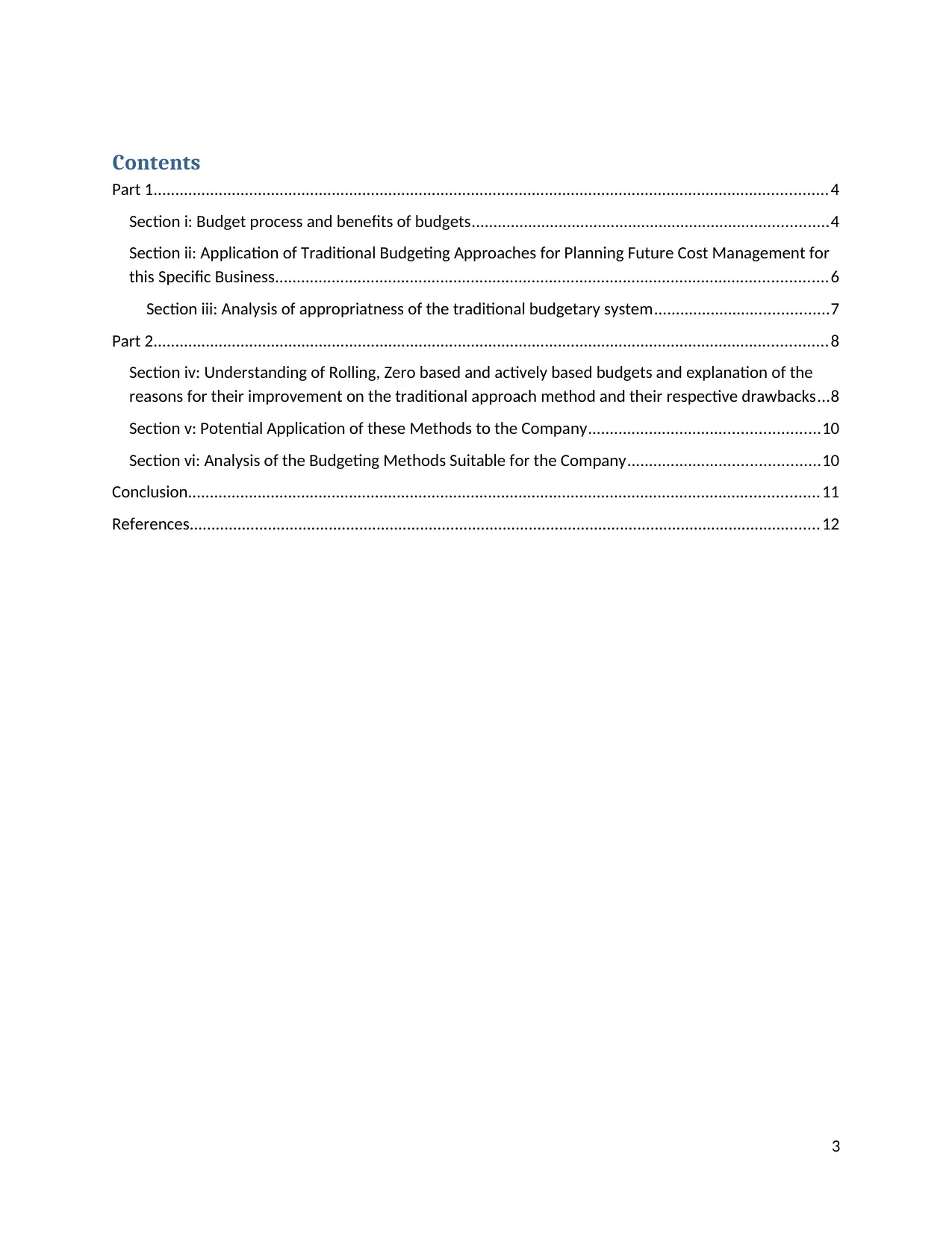
Contents
Part 1...........................................................................................................................................................4
Section i: Budget process and benefits of budgets..................................................................................4
Section ii: Application of Traditional Budgeting Approaches for Planning Future Cost Management for
this Specific Business...............................................................................................................................6
Section iii: Analysis of appropriatness of the traditional budgetary system........................................7
Part 2...........................................................................................................................................................8
Section iv: Understanding of Rolling, Zero based and actively based budgets and explanation of the
reasons for their improvement on the traditional approach method and their respective drawbacks...8
Section v: Potential Application of these Methods to the Company.....................................................10
Section vi: Analysis of the Budgeting Methods Suitable for the Company............................................10
Conclusion.................................................................................................................................................11
References.................................................................................................................................................12
3
Part 1...........................................................................................................................................................4
Section i: Budget process and benefits of budgets..................................................................................4
Section ii: Application of Traditional Budgeting Approaches for Planning Future Cost Management for
this Specific Business...............................................................................................................................6
Section iii: Analysis of appropriatness of the traditional budgetary system........................................7
Part 2...........................................................................................................................................................8
Section iv: Understanding of Rolling, Zero based and actively based budgets and explanation of the
reasons for their improvement on the traditional approach method and their respective drawbacks...8
Section v: Potential Application of these Methods to the Company.....................................................10
Section vi: Analysis of the Budgeting Methods Suitable for the Company............................................10
Conclusion.................................................................................................................................................11
References.................................................................................................................................................12
3
⊘ This is a preview!⊘
Do you want full access?
Subscribe today to unlock all pages.

Trusted by 1+ million students worldwide
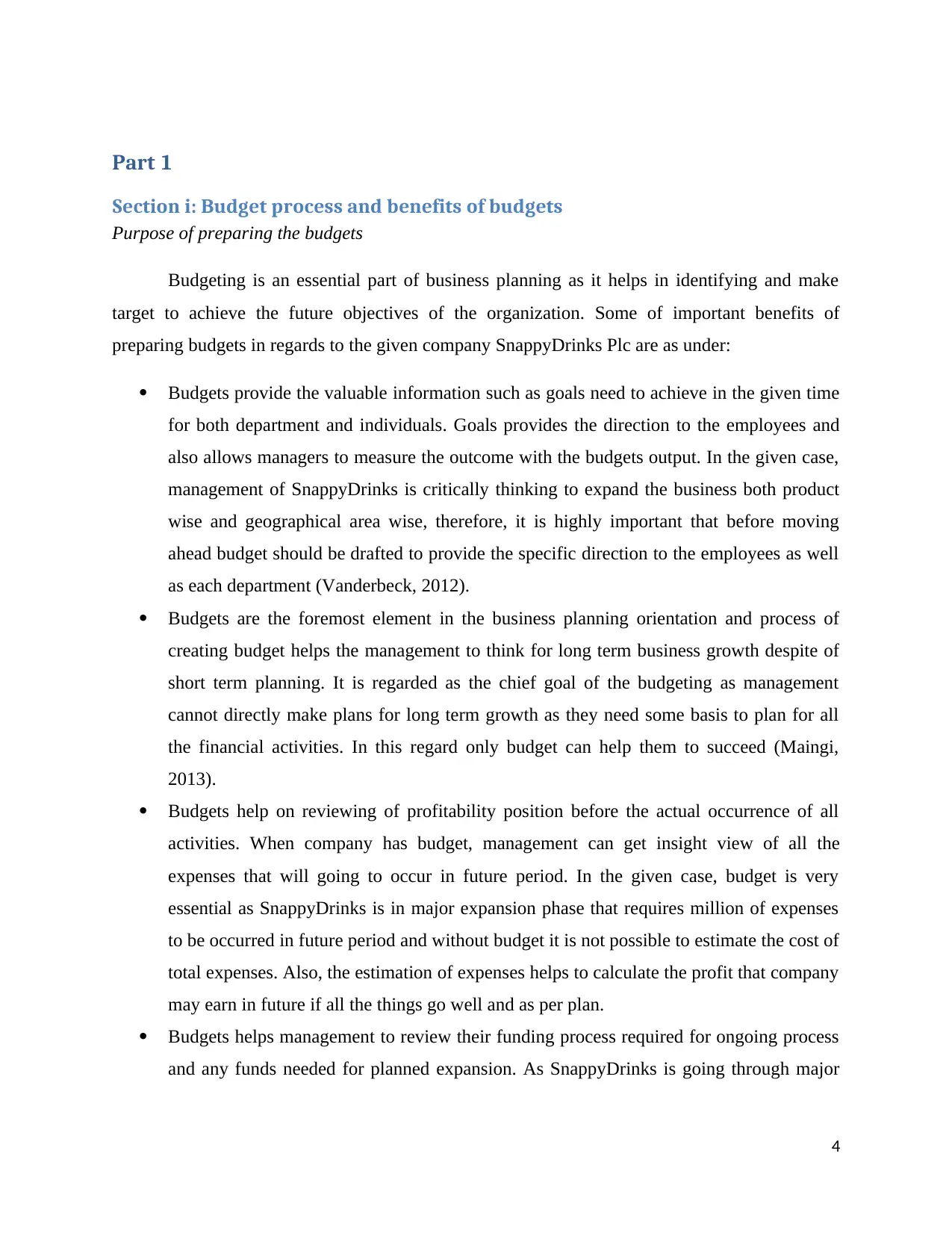
Part 1
Section i: Budget process and benefits of budgets
Purpose of preparing the budgets
Budgeting is an essential part of business planning as it helps in identifying and make
target to achieve the future objectives of the organization. Some of important benefits of
preparing budgets in regards to the given company SnappyDrinks Plc are as under:
Budgets provide the valuable information such as goals need to achieve in the given time
for both department and individuals. Goals provides the direction to the employees and
also allows managers to measure the outcome with the budgets output. In the given case,
management of SnappyDrinks is critically thinking to expand the business both product
wise and geographical area wise, therefore, it is highly important that before moving
ahead budget should be drafted to provide the specific direction to the employees as well
as each department (Vanderbeck, 2012).
Budgets are the foremost element in the business planning orientation and process of
creating budget helps the management to think for long term business growth despite of
short term planning. It is regarded as the chief goal of the budgeting as management
cannot directly make plans for long term growth as they need some basis to plan for all
the financial activities. In this regard only budget can help them to succeed (Maingi,
2013).
Budgets help on reviewing of profitability position before the actual occurrence of all
activities. When company has budget, management can get insight view of all the
expenses that will going to occur in future period. In the given case, budget is very
essential as SnappyDrinks is in major expansion phase that requires million of expenses
to be occurred in future period and without budget it is not possible to estimate the cost of
total expenses. Also, the estimation of expenses helps to calculate the profit that company
may earn in future if all the things go well and as per plan.
Budgets helps management to review their funding process required for ongoing process
and any funds needed for planned expansion. As SnappyDrinks is going through major
4
Section i: Budget process and benefits of budgets
Purpose of preparing the budgets
Budgeting is an essential part of business planning as it helps in identifying and make
target to achieve the future objectives of the organization. Some of important benefits of
preparing budgets in regards to the given company SnappyDrinks Plc are as under:
Budgets provide the valuable information such as goals need to achieve in the given time
for both department and individuals. Goals provides the direction to the employees and
also allows managers to measure the outcome with the budgets output. In the given case,
management of SnappyDrinks is critically thinking to expand the business both product
wise and geographical area wise, therefore, it is highly important that before moving
ahead budget should be drafted to provide the specific direction to the employees as well
as each department (Vanderbeck, 2012).
Budgets are the foremost element in the business planning orientation and process of
creating budget helps the management to think for long term business growth despite of
short term planning. It is regarded as the chief goal of the budgeting as management
cannot directly make plans for long term growth as they need some basis to plan for all
the financial activities. In this regard only budget can help them to succeed (Maingi,
2013).
Budgets help on reviewing of profitability position before the actual occurrence of all
activities. When company has budget, management can get insight view of all the
expenses that will going to occur in future period. In the given case, budget is very
essential as SnappyDrinks is in major expansion phase that requires million of expenses
to be occurred in future period and without budget it is not possible to estimate the cost of
total expenses. Also, the estimation of expenses helps to calculate the profit that company
may earn in future if all the things go well and as per plan.
Budgets helps management to review their funding process required for ongoing process
and any funds needed for planned expansion. As SnappyDrinks is going through major
4
Paraphrase This Document
Need a fresh take? Get an instant paraphrase of this document with our AI Paraphraser
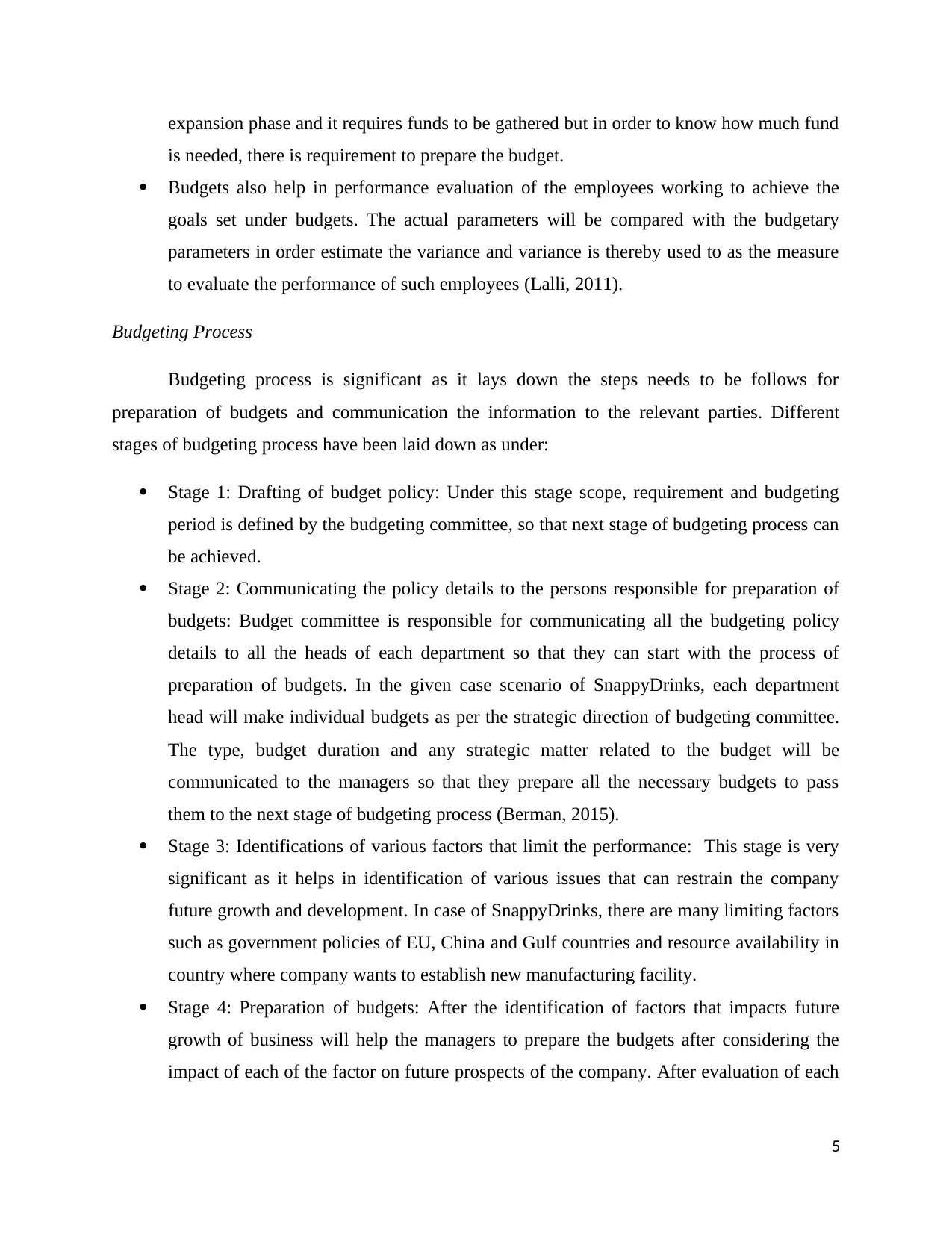
expansion phase and it requires funds to be gathered but in order to know how much fund
is needed, there is requirement to prepare the budget.
Budgets also help in performance evaluation of the employees working to achieve the
goals set under budgets. The actual parameters will be compared with the budgetary
parameters in order estimate the variance and variance is thereby used to as the measure
to evaluate the performance of such employees (Lalli, 2011).
Budgeting Process
Budgeting process is significant as it lays down the steps needs to be follows for
preparation of budgets and communication the information to the relevant parties. Different
stages of budgeting process have been laid down as under:
Stage 1: Drafting of budget policy: Under this stage scope, requirement and budgeting
period is defined by the budgeting committee, so that next stage of budgeting process can
be achieved.
Stage 2: Communicating the policy details to the persons responsible for preparation of
budgets: Budget committee is responsible for communicating all the budgeting policy
details to all the heads of each department so that they can start with the process of
preparation of budgets. In the given case scenario of SnappyDrinks, each department
head will make individual budgets as per the strategic direction of budgeting committee.
The type, budget duration and any strategic matter related to the budget will be
communicated to the managers so that they prepare all the necessary budgets to pass
them to the next stage of budgeting process (Berman, 2015).
Stage 3: Identifications of various factors that limit the performance: This stage is very
significant as it helps in identification of various issues that can restrain the company
future growth and development. In case of SnappyDrinks, there are many limiting factors
such as government policies of EU, China and Gulf countries and resource availability in
country where company wants to establish new manufacturing facility.
Stage 4: Preparation of budgets: After the identification of factors that impacts future
growth of business will help the managers to prepare the budgets after considering the
impact of each of the factor on future prospects of the company. After evaluation of each
5
is needed, there is requirement to prepare the budget.
Budgets also help in performance evaluation of the employees working to achieve the
goals set under budgets. The actual parameters will be compared with the budgetary
parameters in order estimate the variance and variance is thereby used to as the measure
to evaluate the performance of such employees (Lalli, 2011).
Budgeting Process
Budgeting process is significant as it lays down the steps needs to be follows for
preparation of budgets and communication the information to the relevant parties. Different
stages of budgeting process have been laid down as under:
Stage 1: Drafting of budget policy: Under this stage scope, requirement and budgeting
period is defined by the budgeting committee, so that next stage of budgeting process can
be achieved.
Stage 2: Communicating the policy details to the persons responsible for preparation of
budgets: Budget committee is responsible for communicating all the budgeting policy
details to all the heads of each department so that they can start with the process of
preparation of budgets. In the given case scenario of SnappyDrinks, each department
head will make individual budgets as per the strategic direction of budgeting committee.
The type, budget duration and any strategic matter related to the budget will be
communicated to the managers so that they prepare all the necessary budgets to pass
them to the next stage of budgeting process (Berman, 2015).
Stage 3: Identifications of various factors that limit the performance: This stage is very
significant as it helps in identification of various issues that can restrain the company
future growth and development. In case of SnappyDrinks, there are many limiting factors
such as government policies of EU, China and Gulf countries and resource availability in
country where company wants to establish new manufacturing facility.
Stage 4: Preparation of budgets: After the identification of factors that impacts future
growth of business will help the managers to prepare the budgets after considering the
impact of each of the factor on future prospects of the company. After evaluation of each
5
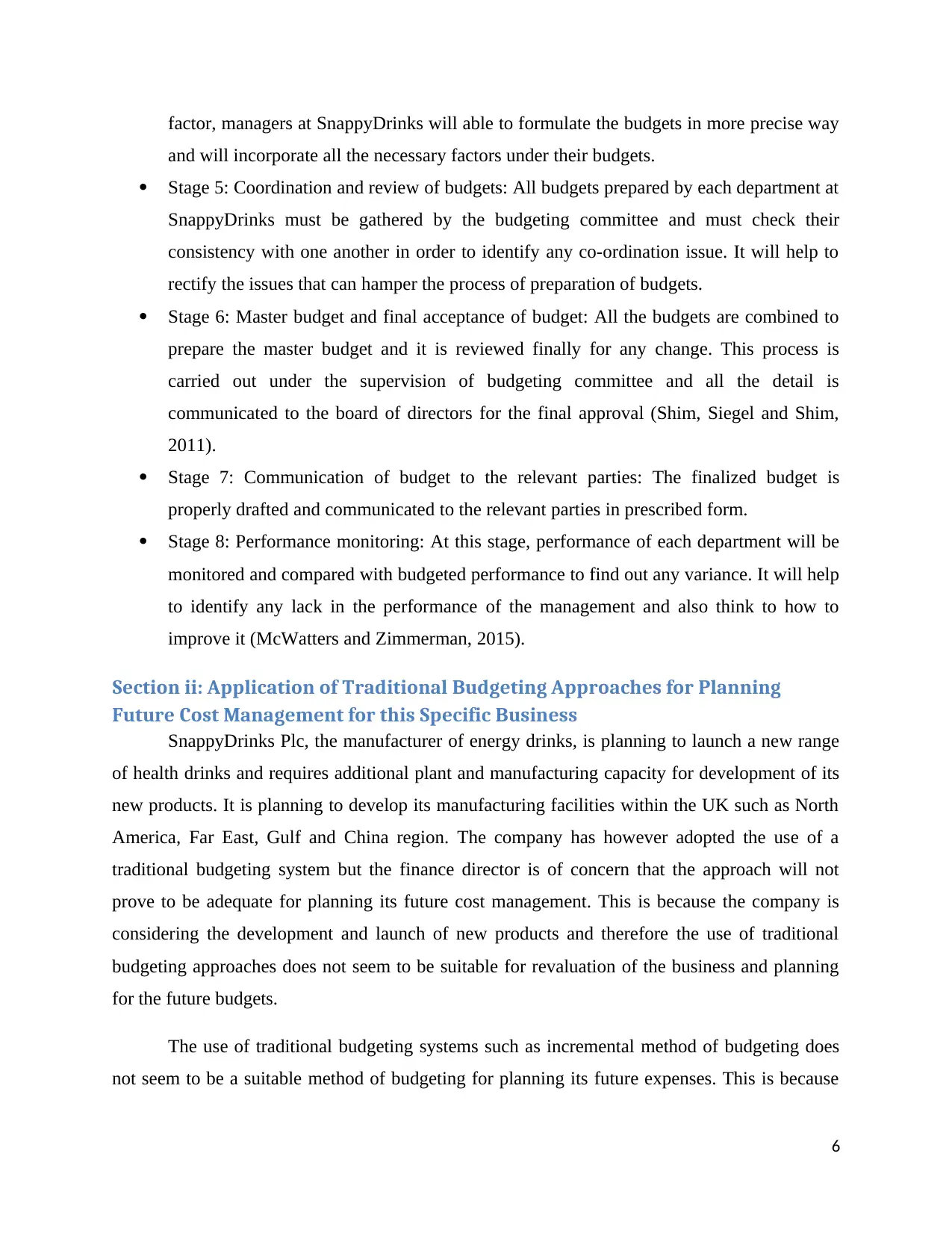
factor, managers at SnappyDrinks will able to formulate the budgets in more precise way
and will incorporate all the necessary factors under their budgets.
Stage 5: Coordination and review of budgets: All budgets prepared by each department at
SnappyDrinks must be gathered by the budgeting committee and must check their
consistency with one another in order to identify any co-ordination issue. It will help to
rectify the issues that can hamper the process of preparation of budgets.
Stage 6: Master budget and final acceptance of budget: All the budgets are combined to
prepare the master budget and it is reviewed finally for any change. This process is
carried out under the supervision of budgeting committee and all the detail is
communicated to the board of directors for the final approval (Shim, Siegel and Shim,
2011).
Stage 7: Communication of budget to the relevant parties: The finalized budget is
properly drafted and communicated to the relevant parties in prescribed form.
Stage 8: Performance monitoring: At this stage, performance of each department will be
monitored and compared with budgeted performance to find out any variance. It will help
to identify any lack in the performance of the management and also think to how to
improve it (McWatters and Zimmerman, 2015).
Section ii: Application of Traditional Budgeting Approaches for Planning
Future Cost Management for this Specific Business
SnappyDrinks Plc, the manufacturer of energy drinks, is planning to launch a new range
of health drinks and requires additional plant and manufacturing capacity for development of its
new products. It is planning to develop its manufacturing facilities within the UK such as North
America, Far East, Gulf and China region. The company has however adopted the use of a
traditional budgeting system but the finance director is of concern that the approach will not
prove to be adequate for planning its future cost management. This is because the company is
considering the development and launch of new products and therefore the use of traditional
budgeting approaches does not seem to be suitable for revaluation of the business and planning
for the future budgets.
The use of traditional budgeting systems such as incremental method of budgeting does
not seem to be a suitable method of budgeting for planning its future expenses. This is because
6
and will incorporate all the necessary factors under their budgets.
Stage 5: Coordination and review of budgets: All budgets prepared by each department at
SnappyDrinks must be gathered by the budgeting committee and must check their
consistency with one another in order to identify any co-ordination issue. It will help to
rectify the issues that can hamper the process of preparation of budgets.
Stage 6: Master budget and final acceptance of budget: All the budgets are combined to
prepare the master budget and it is reviewed finally for any change. This process is
carried out under the supervision of budgeting committee and all the detail is
communicated to the board of directors for the final approval (Shim, Siegel and Shim,
2011).
Stage 7: Communication of budget to the relevant parties: The finalized budget is
properly drafted and communicated to the relevant parties in prescribed form.
Stage 8: Performance monitoring: At this stage, performance of each department will be
monitored and compared with budgeted performance to find out any variance. It will help
to identify any lack in the performance of the management and also think to how to
improve it (McWatters and Zimmerman, 2015).
Section ii: Application of Traditional Budgeting Approaches for Planning
Future Cost Management for this Specific Business
SnappyDrinks Plc, the manufacturer of energy drinks, is planning to launch a new range
of health drinks and requires additional plant and manufacturing capacity for development of its
new products. It is planning to develop its manufacturing facilities within the UK such as North
America, Far East, Gulf and China region. The company has however adopted the use of a
traditional budgeting system but the finance director is of concern that the approach will not
prove to be adequate for planning its future cost management. This is because the company is
considering the development and launch of new products and therefore the use of traditional
budgeting approaches does not seem to be suitable for revaluation of the business and planning
for the future budgets.
The use of traditional budgeting systems such as incremental method of budgeting does
not seem to be a suitable method of budgeting for planning its future expenses. This is because
6
⊘ This is a preview!⊘
Do you want full access?
Subscribe today to unlock all pages.

Trusted by 1+ million students worldwide
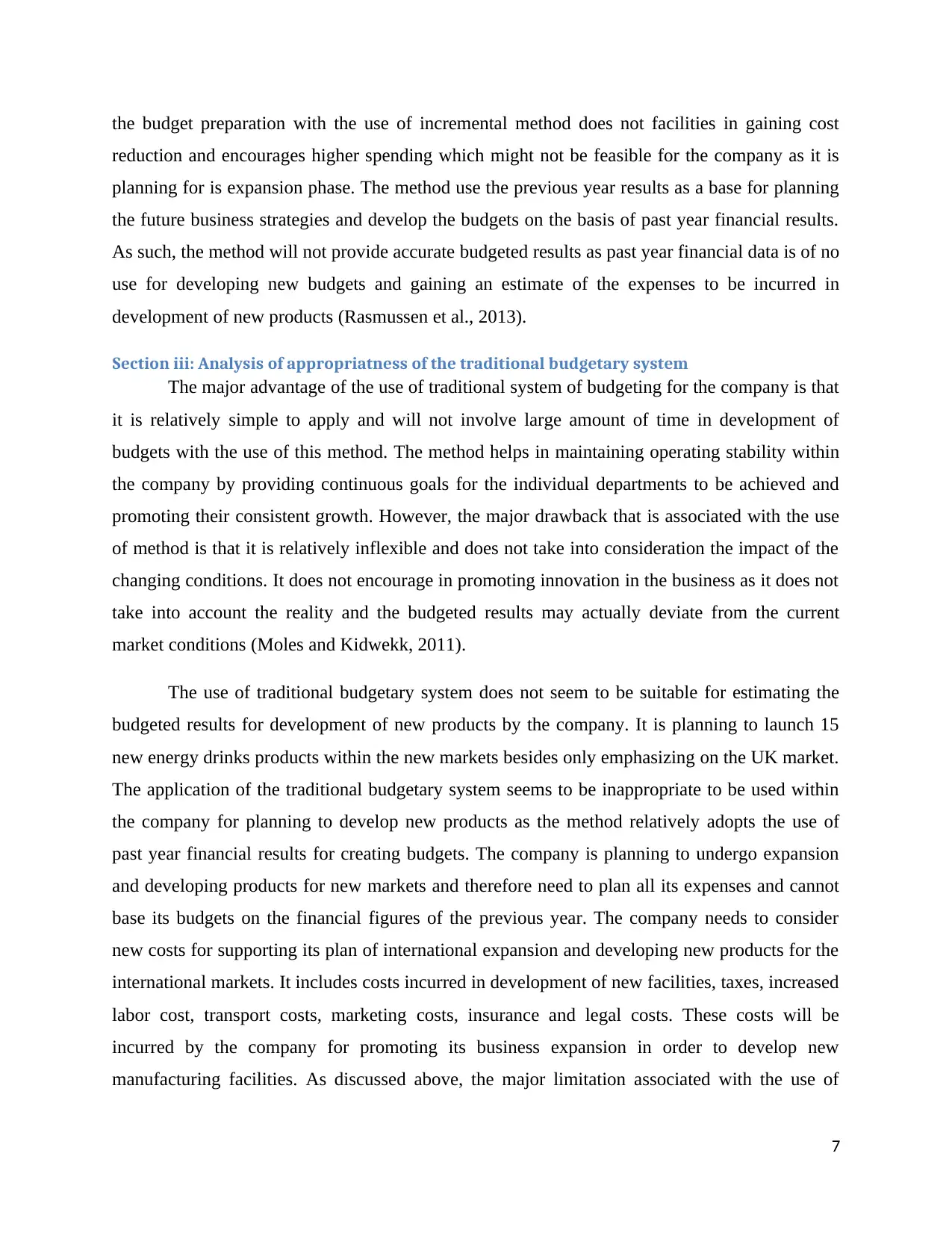
the budget preparation with the use of incremental method does not facilities in gaining cost
reduction and encourages higher spending which might not be feasible for the company as it is
planning for is expansion phase. The method use the previous year results as a base for planning
the future business strategies and develop the budgets on the basis of past year financial results.
As such, the method will not provide accurate budgeted results as past year financial data is of no
use for developing new budgets and gaining an estimate of the expenses to be incurred in
development of new products (Rasmussen et al., 2013).
Section iii: Analysis of appropriatness of the traditional budgetary system
The major advantage of the use of traditional system of budgeting for the company is that
it is relatively simple to apply and will not involve large amount of time in development of
budgets with the use of this method. The method helps in maintaining operating stability within
the company by providing continuous goals for the individual departments to be achieved and
promoting their consistent growth. However, the major drawback that is associated with the use
of method is that it is relatively inflexible and does not take into consideration the impact of the
changing conditions. It does not encourage in promoting innovation in the business as it does not
take into account the reality and the budgeted results may actually deviate from the current
market conditions (Moles and Kidwekk, 2011).
The use of traditional budgetary system does not seem to be suitable for estimating the
budgeted results for development of new products by the company. It is planning to launch 15
new energy drinks products within the new markets besides only emphasizing on the UK market.
The application of the traditional budgetary system seems to be inappropriate to be used within
the company for planning to develop new products as the method relatively adopts the use of
past year financial results for creating budgets. The company is planning to undergo expansion
and developing products for new markets and therefore need to plan all its expenses and cannot
base its budgets on the financial figures of the previous year. The company needs to consider
new costs for supporting its plan of international expansion and developing new products for the
international markets. It includes costs incurred in development of new facilities, taxes, increased
labor cost, transport costs, marketing costs, insurance and legal costs. These costs will be
incurred by the company for promoting its business expansion in order to develop new
manufacturing facilities. As discussed above, the major limitation associated with the use of
7
reduction and encourages higher spending which might not be feasible for the company as it is
planning for is expansion phase. The method use the previous year results as a base for planning
the future business strategies and develop the budgets on the basis of past year financial results.
As such, the method will not provide accurate budgeted results as past year financial data is of no
use for developing new budgets and gaining an estimate of the expenses to be incurred in
development of new products (Rasmussen et al., 2013).
Section iii: Analysis of appropriatness of the traditional budgetary system
The major advantage of the use of traditional system of budgeting for the company is that
it is relatively simple to apply and will not involve large amount of time in development of
budgets with the use of this method. The method helps in maintaining operating stability within
the company by providing continuous goals for the individual departments to be achieved and
promoting their consistent growth. However, the major drawback that is associated with the use
of method is that it is relatively inflexible and does not take into consideration the impact of the
changing conditions. It does not encourage in promoting innovation in the business as it does not
take into account the reality and the budgeted results may actually deviate from the current
market conditions (Moles and Kidwekk, 2011).
The use of traditional budgetary system does not seem to be suitable for estimating the
budgeted results for development of new products by the company. It is planning to launch 15
new energy drinks products within the new markets besides only emphasizing on the UK market.
The application of the traditional budgetary system seems to be inappropriate to be used within
the company for planning to develop new products as the method relatively adopts the use of
past year financial results for creating budgets. The company is planning to undergo expansion
and developing products for new markets and therefore need to plan all its expenses and cannot
base its budgets on the financial figures of the previous year. The company needs to consider
new costs for supporting its plan of international expansion and developing new products for the
international markets. It includes costs incurred in development of new facilities, taxes, increased
labor cost, transport costs, marketing costs, insurance and legal costs. These costs will be
incurred by the company for promoting its business expansion in order to develop new
manufacturing facilities. As discussed above, the major limitation associated with the use of
7
Paraphrase This Document
Need a fresh take? Get an instant paraphrase of this document with our AI Paraphraser
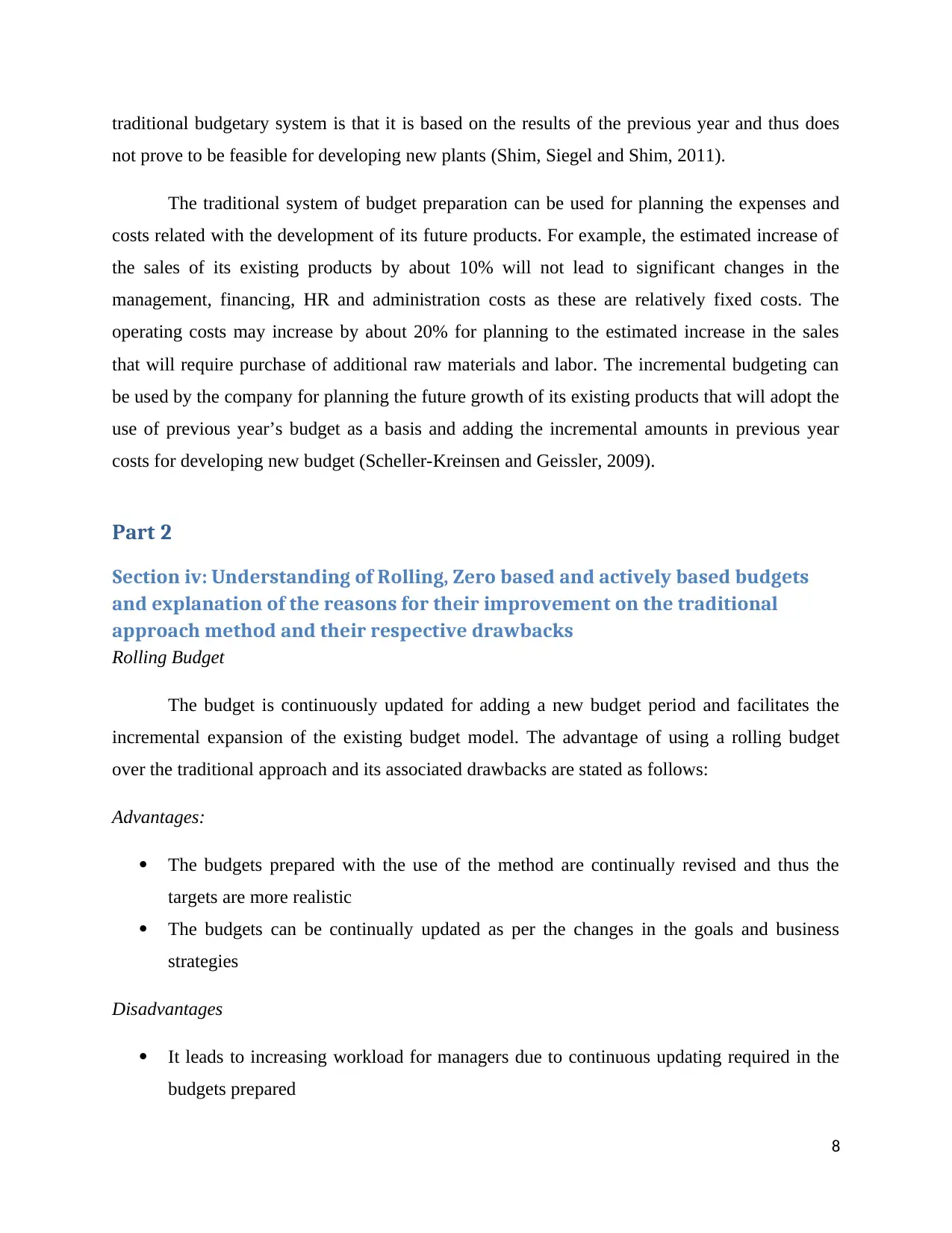
traditional budgetary system is that it is based on the results of the previous year and thus does
not prove to be feasible for developing new plants (Shim, Siegel and Shim, 2011).
The traditional system of budget preparation can be used for planning the expenses and
costs related with the development of its future products. For example, the estimated increase of
the sales of its existing products by about 10% will not lead to significant changes in the
management, financing, HR and administration costs as these are relatively fixed costs. The
operating costs may increase by about 20% for planning to the estimated increase in the sales
that will require purchase of additional raw materials and labor. The incremental budgeting can
be used by the company for planning the future growth of its existing products that will adopt the
use of previous year’s budget as a basis and adding the incremental amounts in previous year
costs for developing new budget (Scheller-Kreinsen and Geissler, 2009).
Part 2
Section iv: Understanding of Rolling, Zero based and actively based budgets
and explanation of the reasons for their improvement on the traditional
approach method and their respective drawbacks
Rolling Budget
The budget is continuously updated for adding a new budget period and facilitates the
incremental expansion of the existing budget model. The advantage of using a rolling budget
over the traditional approach and its associated drawbacks are stated as follows:
Advantages:
The budgets prepared with the use of the method are continually revised and thus the
targets are more realistic
The budgets can be continually updated as per the changes in the goals and business
strategies
Disadvantages
It leads to increasing workload for managers due to continuous updating required in the
budgets prepared
8
not prove to be feasible for developing new plants (Shim, Siegel and Shim, 2011).
The traditional system of budget preparation can be used for planning the expenses and
costs related with the development of its future products. For example, the estimated increase of
the sales of its existing products by about 10% will not lead to significant changes in the
management, financing, HR and administration costs as these are relatively fixed costs. The
operating costs may increase by about 20% for planning to the estimated increase in the sales
that will require purchase of additional raw materials and labor. The incremental budgeting can
be used by the company for planning the future growth of its existing products that will adopt the
use of previous year’s budget as a basis and adding the incremental amounts in previous year
costs for developing new budget (Scheller-Kreinsen and Geissler, 2009).
Part 2
Section iv: Understanding of Rolling, Zero based and actively based budgets
and explanation of the reasons for their improvement on the traditional
approach method and their respective drawbacks
Rolling Budget
The budget is continuously updated for adding a new budget period and facilitates the
incremental expansion of the existing budget model. The advantage of using a rolling budget
over the traditional approach and its associated drawbacks are stated as follows:
Advantages:
The budgets prepared with the use of the method are continually revised and thus the
targets are more realistic
The budgets can be continually updated as per the changes in the goals and business
strategies
Disadvantages
It leads to increasing workload for managers due to continuous updating required in the
budgets prepared
8
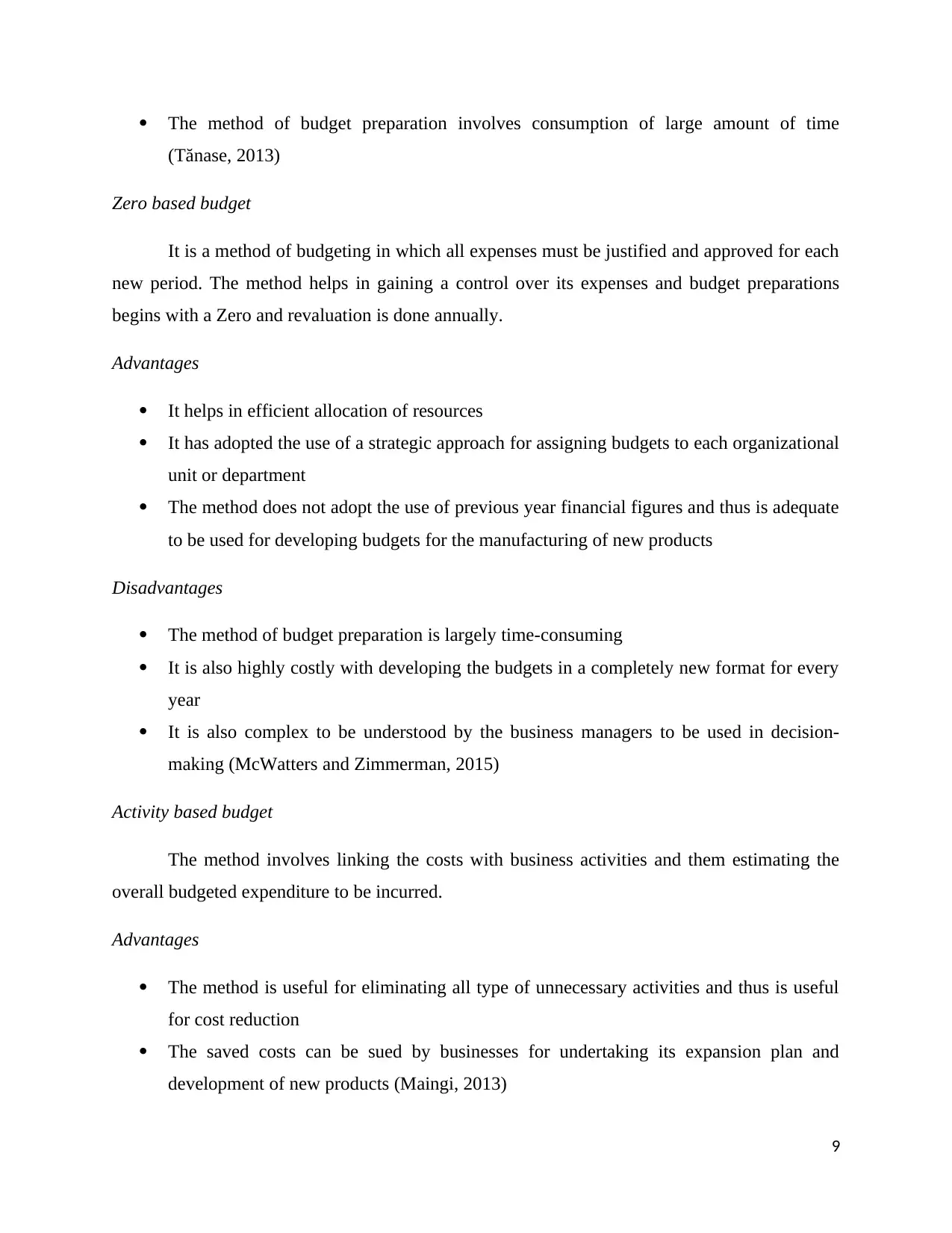
The method of budget preparation involves consumption of large amount of time
(Tănase, 2013)
Zero based budget
It is a method of budgeting in which all expenses must be justified and approved for each
new period. The method helps in gaining a control over its expenses and budget preparations
begins with a Zero and revaluation is done annually.
Advantages
It helps in efficient allocation of resources
It has adopted the use of a strategic approach for assigning budgets to each organizational
unit or department
The method does not adopt the use of previous year financial figures and thus is adequate
to be used for developing budgets for the manufacturing of new products
Disadvantages
The method of budget preparation is largely time-consuming
It is also highly costly with developing the budgets in a completely new format for every
year
It is also complex to be understood by the business managers to be used in decision-
making (McWatters and Zimmerman, 2015)
Activity based budget
The method involves linking the costs with business activities and them estimating the
overall budgeted expenditure to be incurred.
Advantages
The method is useful for eliminating all type of unnecessary activities and thus is useful
for cost reduction
The saved costs can be sued by businesses for undertaking its expansion plan and
development of new products (Maingi, 2013)
9
(Tănase, 2013)
Zero based budget
It is a method of budgeting in which all expenses must be justified and approved for each
new period. The method helps in gaining a control over its expenses and budget preparations
begins with a Zero and revaluation is done annually.
Advantages
It helps in efficient allocation of resources
It has adopted the use of a strategic approach for assigning budgets to each organizational
unit or department
The method does not adopt the use of previous year financial figures and thus is adequate
to be used for developing budgets for the manufacturing of new products
Disadvantages
The method of budget preparation is largely time-consuming
It is also highly costly with developing the budgets in a completely new format for every
year
It is also complex to be understood by the business managers to be used in decision-
making (McWatters and Zimmerman, 2015)
Activity based budget
The method involves linking the costs with business activities and them estimating the
overall budgeted expenditure to be incurred.
Advantages
The method is useful for eliminating all type of unnecessary activities and thus is useful
for cost reduction
The saved costs can be sued by businesses for undertaking its expansion plan and
development of new products (Maingi, 2013)
9
⊘ This is a preview!⊘
Do you want full access?
Subscribe today to unlock all pages.

Trusted by 1+ million students worldwide
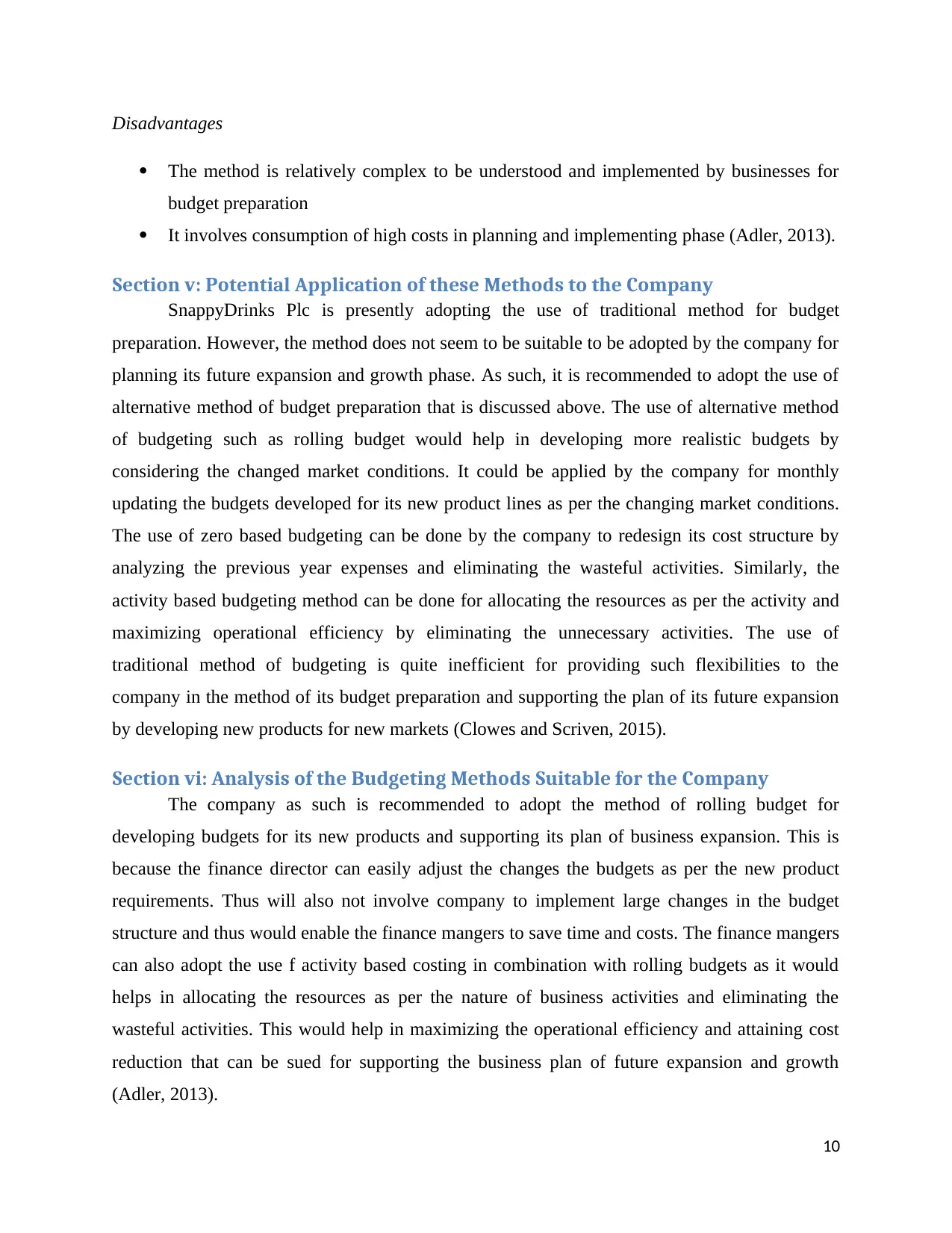
Disadvantages
The method is relatively complex to be understood and implemented by businesses for
budget preparation
It involves consumption of high costs in planning and implementing phase (Adler, 2013).
Section v: Potential Application of these Methods to the Company
SnappyDrinks Plc is presently adopting the use of traditional method for budget
preparation. However, the method does not seem to be suitable to be adopted by the company for
planning its future expansion and growth phase. As such, it is recommended to adopt the use of
alternative method of budget preparation that is discussed above. The use of alternative method
of budgeting such as rolling budget would help in developing more realistic budgets by
considering the changed market conditions. It could be applied by the company for monthly
updating the budgets developed for its new product lines as per the changing market conditions.
The use of zero based budgeting can be done by the company to redesign its cost structure by
analyzing the previous year expenses and eliminating the wasteful activities. Similarly, the
activity based budgeting method can be done for allocating the resources as per the activity and
maximizing operational efficiency by eliminating the unnecessary activities. The use of
traditional method of budgeting is quite inefficient for providing such flexibilities to the
company in the method of its budget preparation and supporting the plan of its future expansion
by developing new products for new markets (Clowes and Scriven, 2015).
Section vi: Analysis of the Budgeting Methods Suitable for the Company
The company as such is recommended to adopt the method of rolling budget for
developing budgets for its new products and supporting its plan of business expansion. This is
because the finance director can easily adjust the changes the budgets as per the new product
requirements. Thus will also not involve company to implement large changes in the budget
structure and thus would enable the finance mangers to save time and costs. The finance mangers
can also adopt the use f activity based costing in combination with rolling budgets as it would
helps in allocating the resources as per the nature of business activities and eliminating the
wasteful activities. This would help in maximizing the operational efficiency and attaining cost
reduction that can be sued for supporting the business plan of future expansion and growth
(Adler, 2013).
10
The method is relatively complex to be understood and implemented by businesses for
budget preparation
It involves consumption of high costs in planning and implementing phase (Adler, 2013).
Section v: Potential Application of these Methods to the Company
SnappyDrinks Plc is presently adopting the use of traditional method for budget
preparation. However, the method does not seem to be suitable to be adopted by the company for
planning its future expansion and growth phase. As such, it is recommended to adopt the use of
alternative method of budget preparation that is discussed above. The use of alternative method
of budgeting such as rolling budget would help in developing more realistic budgets by
considering the changed market conditions. It could be applied by the company for monthly
updating the budgets developed for its new product lines as per the changing market conditions.
The use of zero based budgeting can be done by the company to redesign its cost structure by
analyzing the previous year expenses and eliminating the wasteful activities. Similarly, the
activity based budgeting method can be done for allocating the resources as per the activity and
maximizing operational efficiency by eliminating the unnecessary activities. The use of
traditional method of budgeting is quite inefficient for providing such flexibilities to the
company in the method of its budget preparation and supporting the plan of its future expansion
by developing new products for new markets (Clowes and Scriven, 2015).
Section vi: Analysis of the Budgeting Methods Suitable for the Company
The company as such is recommended to adopt the method of rolling budget for
developing budgets for its new products and supporting its plan of business expansion. This is
because the finance director can easily adjust the changes the budgets as per the new product
requirements. Thus will also not involve company to implement large changes in the budget
structure and thus would enable the finance mangers to save time and costs. The finance mangers
can also adopt the use f activity based costing in combination with rolling budgets as it would
helps in allocating the resources as per the nature of business activities and eliminating the
wasteful activities. This would help in maximizing the operational efficiency and attaining cost
reduction that can be sued for supporting the business plan of future expansion and growth
(Adler, 2013).
10
Paraphrase This Document
Need a fresh take? Get an instant paraphrase of this document with our AI Paraphraser
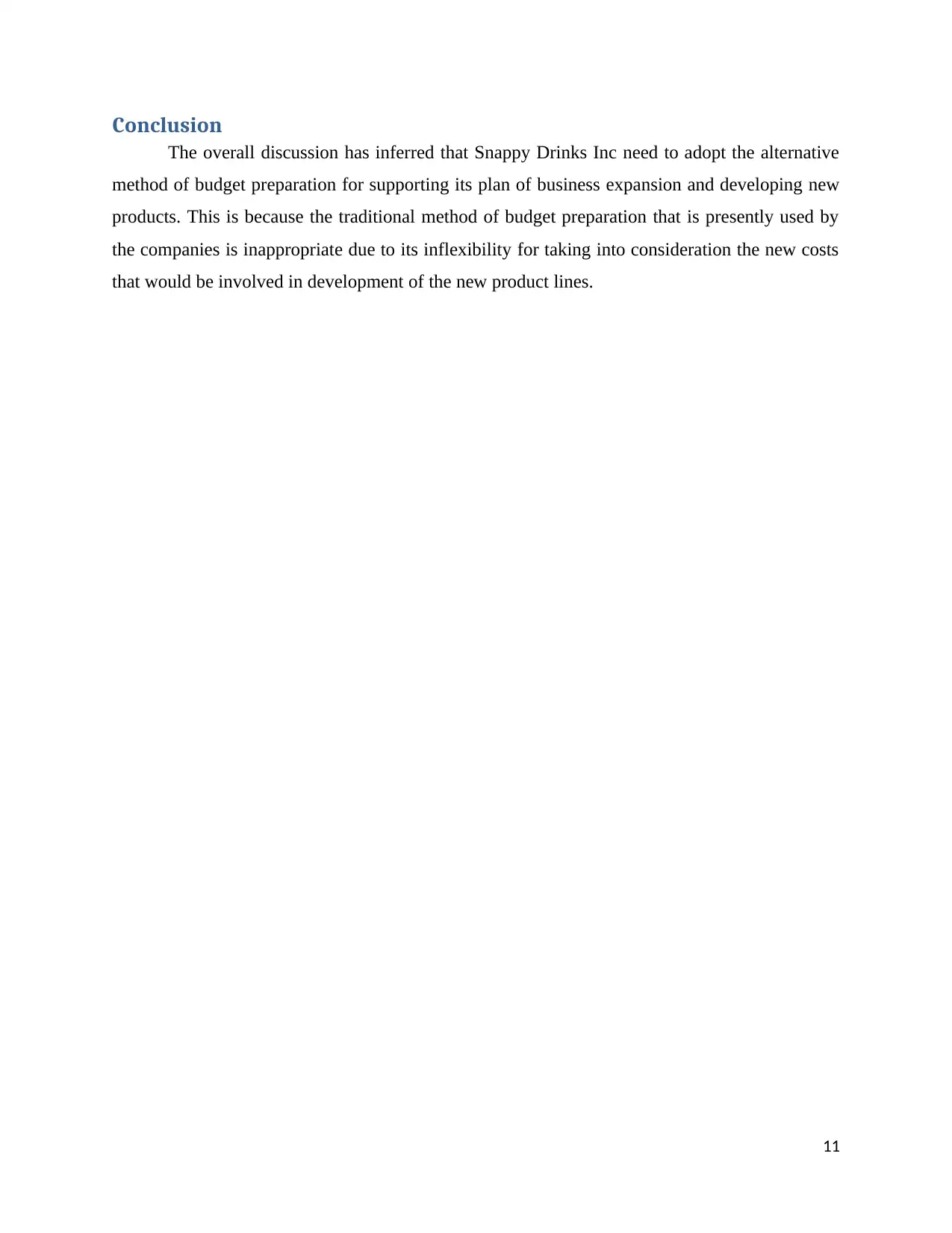
Conclusion
The overall discussion has inferred that Snappy Drinks Inc need to adopt the alternative
method of budget preparation for supporting its plan of business expansion and developing new
products. This is because the traditional method of budget preparation that is presently used by
the companies is inappropriate due to its inflexibility for taking into consideration the new costs
that would be involved in development of the new product lines.
11
The overall discussion has inferred that Snappy Drinks Inc need to adopt the alternative
method of budget preparation for supporting its plan of business expansion and developing new
products. This is because the traditional method of budget preparation that is presently used by
the companies is inappropriate due to its inflexibility for taking into consideration the new costs
that would be involved in development of the new product lines.
11
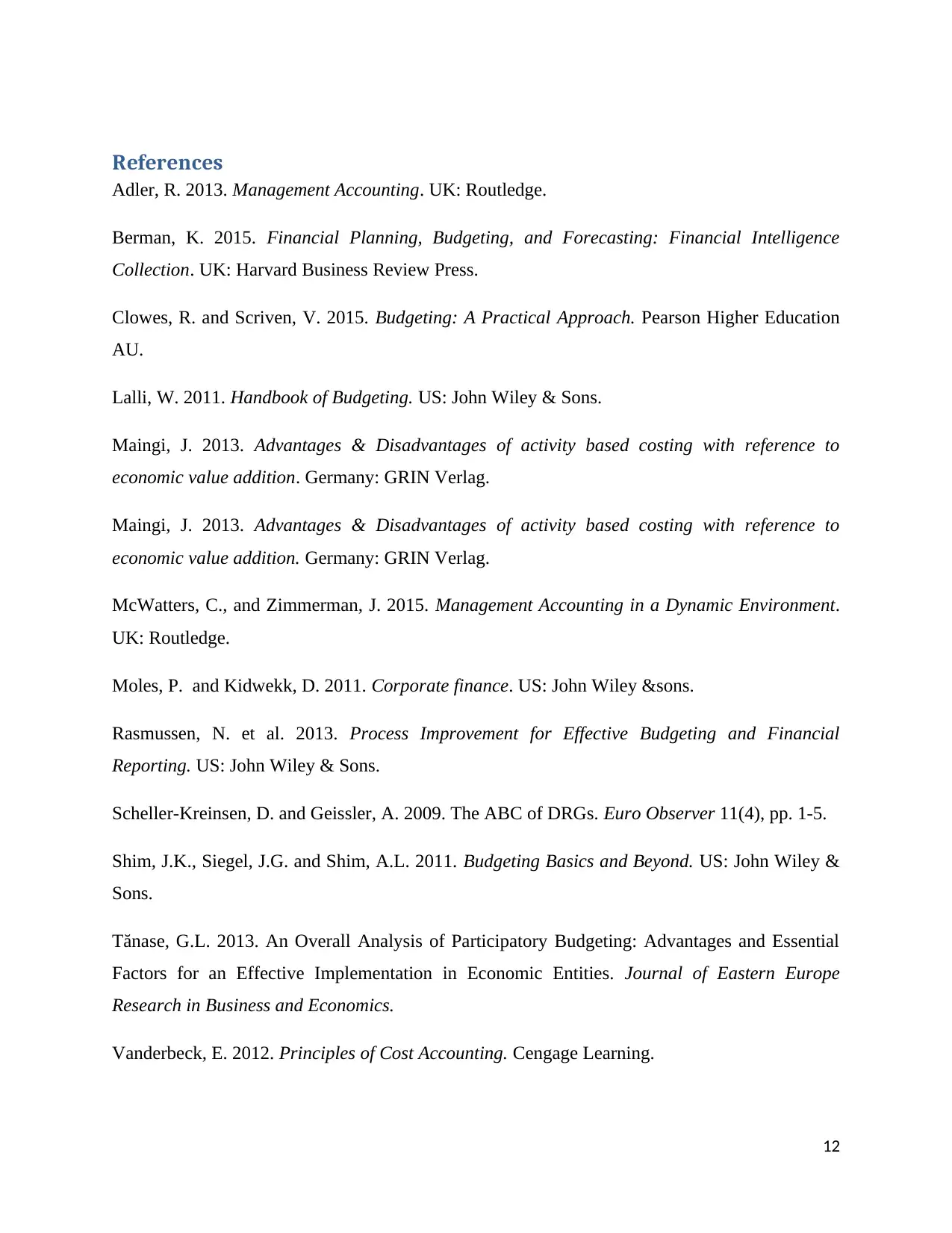
References
Adler, R. 2013. Management Accounting. UK: Routledge.
Berman, K. 2015. Financial Planning, Budgeting, and Forecasting: Financial Intelligence
Collection. UK: Harvard Business Review Press.
Clowes, R. and Scriven, V. 2015. Budgeting: A Practical Approach. Pearson Higher Education
AU.
Lalli, W. 2011. Handbook of Budgeting. US: John Wiley & Sons.
Maingi, J. 2013. Advantages & Disadvantages of activity based costing with reference to
economic value addition. Germany: GRIN Verlag.
Maingi, J. 2013. Advantages & Disadvantages of activity based costing with reference to
economic value addition. Germany: GRIN Verlag.
McWatters, C., and Zimmerman, J. 2015. Management Accounting in a Dynamic Environment.
UK: Routledge.
Moles, P. and Kidwekk, D. 2011. Corporate finance. US: John Wiley &sons.
Rasmussen, N. et al. 2013. Process Improvement for Effective Budgeting and Financial
Reporting. US: John Wiley & Sons.
Scheller-Kreinsen, D. and Geissler, A. 2009. The ABC of DRGs. Euro Observer 11(4), pp. 1-5.
Shim, J.K., Siegel, J.G. and Shim, A.L. 2011. Budgeting Basics and Beyond. US: John Wiley &
Sons.
Tănase, G.L. 2013. An Overall Analysis of Participatory Budgeting: Advantages and Essential
Factors for an Effective Implementation in Economic Entities. Journal of Eastern Europe
Research in Business and Economics.
Vanderbeck, E. 2012. Principles of Cost Accounting. Cengage Learning.
12
Adler, R. 2013. Management Accounting. UK: Routledge.
Berman, K. 2015. Financial Planning, Budgeting, and Forecasting: Financial Intelligence
Collection. UK: Harvard Business Review Press.
Clowes, R. and Scriven, V. 2015. Budgeting: A Practical Approach. Pearson Higher Education
AU.
Lalli, W. 2011. Handbook of Budgeting. US: John Wiley & Sons.
Maingi, J. 2013. Advantages & Disadvantages of activity based costing with reference to
economic value addition. Germany: GRIN Verlag.
Maingi, J. 2013. Advantages & Disadvantages of activity based costing with reference to
economic value addition. Germany: GRIN Verlag.
McWatters, C., and Zimmerman, J. 2015. Management Accounting in a Dynamic Environment.
UK: Routledge.
Moles, P. and Kidwekk, D. 2011. Corporate finance. US: John Wiley &sons.
Rasmussen, N. et al. 2013. Process Improvement for Effective Budgeting and Financial
Reporting. US: John Wiley & Sons.
Scheller-Kreinsen, D. and Geissler, A. 2009. The ABC of DRGs. Euro Observer 11(4), pp. 1-5.
Shim, J.K., Siegel, J.G. and Shim, A.L. 2011. Budgeting Basics and Beyond. US: John Wiley &
Sons.
Tănase, G.L. 2013. An Overall Analysis of Participatory Budgeting: Advantages and Essential
Factors for an Effective Implementation in Economic Entities. Journal of Eastern Europe
Research in Business and Economics.
Vanderbeck, E. 2012. Principles of Cost Accounting. Cengage Learning.
12
⊘ This is a preview!⊘
Do you want full access?
Subscribe today to unlock all pages.

Trusted by 1+ million students worldwide
1 out of 12
Related Documents
Your All-in-One AI-Powered Toolkit for Academic Success.
+13062052269
info@desklib.com
Available 24*7 on WhatsApp / Email
![[object Object]](/_next/static/media/star-bottom.7253800d.svg)
Unlock your academic potential
Copyright © 2020–2025 A2Z Services. All Rights Reserved. Developed and managed by ZUCOL.

